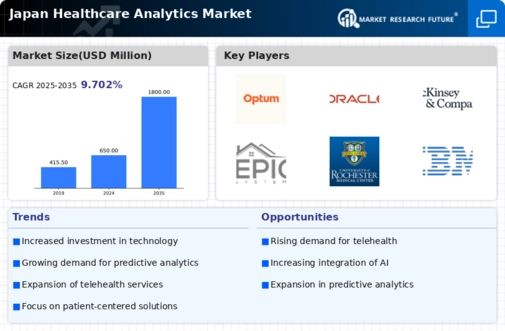Integration of IoT Devices
The integration of Internet of Things (IoT) devices into healthcare systems is significantly influencing the healthcare analytics market in Japan. IoT devices facilitate real-time data collection from patients, enabling healthcare providers to monitor health conditions remotely. This influx of data enhances the ability to analyze patient trends and outcomes, thereby improving decision-making processes. The market for IoT in healthcare is expected to reach approximately $10 billion by 2026, reflecting a growing recognition of the value of connected devices in patient management. Consequently, the healthcare analytics market is poised to benefit from the increased volume of data generated by IoT devices, leading to more comprehensive analytics and improved patient care.
Advancements in Data Interoperability
Advancements in data interoperability are emerging as a key driver for the healthcare analytics market in Japan. The ability to seamlessly share and integrate data across various healthcare systems is essential for effective analytics. Improved interoperability facilitates comprehensive data analysis, enabling healthcare providers to gain deeper insights into patient care and operational efficiency. Recent studies indicate that organizations with high levels of data interoperability can achieve up to 30% better outcomes in patient management. As the healthcare sector continues to prioritize data sharing and integration, the healthcare analytics market is likely to experience robust growth, driven by the demand for solutions that enhance data interoperability.
Rising Demand for Predictive Analytics
The healthcare analytics market in Japan is experiencing a notable surge in demand for predictive analytics. This trend is driven by the need for healthcare providers to anticipate patient outcomes and optimize resource allocation. With an increasing focus on value-based care, predictive analytics enables organizations to identify at-risk populations and implement preventive measures. According to recent data, the market for predictive analytics in healthcare is projected to grow at a CAGR of approximately 25% over the next five years. This growth is indicative of the healthcare sector's commitment to leveraging data-driven insights to enhance patient care and operational efficiency. As a result, the healthcare analytics market is likely to see substantial investments in technologies that support predictive modeling and analytics capabilities.
Growing Emphasis on Patient-Centric Care
The shift towards patient-centric care is significantly impacting the healthcare analytics market in Japan. Healthcare providers are increasingly focusing on understanding patient preferences and experiences to deliver tailored services. This trend necessitates the use of advanced analytics to gather insights from patient data, enabling providers to enhance service delivery and improve patient satisfaction. As a result, the healthcare analytics market is expected to expand, with a projected growth rate of 18% over the next few years. By leveraging analytics, healthcare organizations can better align their services with patient needs, thereby fostering a more responsive and effective healthcare system.
Government Initiatives for Digital Health
Government initiatives aimed at promoting digital health solutions are playing a crucial role in shaping the healthcare analytics market in Japan. The Japanese government has been actively investing in digital health technologies to improve healthcare delivery and patient outcomes. For instance, the Ministry of Health, Labour and Welfare has launched various programs to encourage the adoption of electronic health records and data analytics tools. These initiatives are expected to drive the healthcare analytics market, with projections indicating a growth rate of around 20% annually. By fostering an environment conducive to innovation, the government is likely to enhance the capabilities of healthcare analytics, ultimately benefiting both providers and patients.





















Leave a Comment